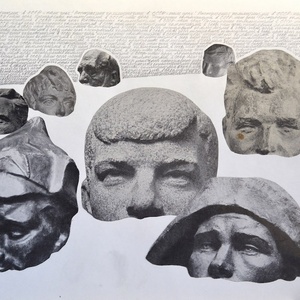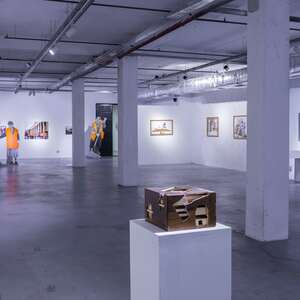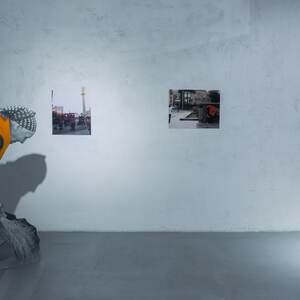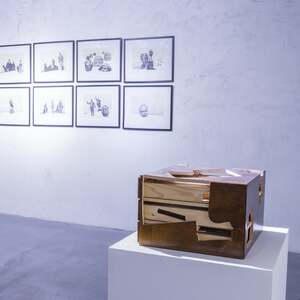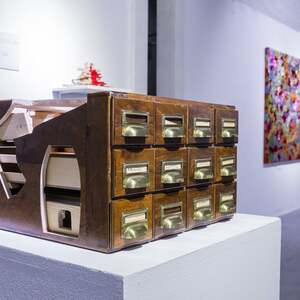All the World's a Collage
Group Show of Central Asian Contemporary Artists
October, 2018 — November, 2018
.jpg)
Aspan Gallery is proud to present a new group show dedicated to the art of collage: All the World’s a Collage! The term ‘collage’ was coined by Georges Braque and Pablo Picasso at the beginning of the 20th century to describe a technique of using cut-outs of printed material glued onto a paper or canvas for support, to create a fragmented pictorial space. ‘Coller’ is French for ‘to glue’. This new form revolutionized art making, bringing together high art and mass culture, while adding an element of randomness and chance.
Collage became one of the main art forms of the Cubists, Dadaists and Pop artists. It also plays an integral role in Central Asian contemporary art.
Even though the traditional collage of Picasso and Braque has not lost its relevance in the 21st century, collage has diversified and expanded, with contemporary 'collage' assuming various forms. This exhibition features six artists from Central Asia, all of whom make active use of collage in different ways and with different goals.
Uzbek artist Vyacheslav Akhunov (b. 1948) has been working with collage since the beginning of his artistic career. For decades he has been collecting and re-appropriating cut-outs from Soviet magazines, posters, albums and other printed materials. His series Mantras of the USSR positions statues of Lenin alongside masterpieces of Western sculpture since antiquity, as if discovered by archaeologists thousands of years in the future. While in these works Akhunov criticizes historic ideologies, his new installation Wandering shows the artist dealing with contemporary society. The installation features hygienic paper "sick bags", usually distributed on planes, containing various artifacts of contemporary life – tickets, receipts, labels, brochures etc., collected by the artist during his trips to the USA and China.
Young Kazakh Berlin-based artist Gulnur Mukazhanova (b. 1984) presents her new series Moment of the Present. Mukazhanova created these works by painstakingly overlaying patterns, which were hand-cut from pieces s of brocade. In Central Asia, brocade is often presented to guests after a celebration, which for the artist therefore acts as a metaphor for the importance of one's surroundings, which are themselves testimonies of the non-verbal interactions in society. In the laborious process of cutting and pasting layer upon layer of varied flower patterns the overall form becomes abstract, and individual pieces of fabric become indiscernible. The focus therefore shifts to the performative aspect of the work.
In his project More than Dreams, Less than Things. Kinetic Object Alexander Ugay (b. 1978) makes use of assemblage: he cuts sewing patterns of male and female Korean national costume out from a wooden filing cabinet, that was once used in a library. The artist then stacked the carved patterns and split them in half, creating a contrast between the straight line and complex patterns. In the installation two ways of organizing information therefore co-exist: the 'universal', structured library catalogue, and traditional costume as the guardian of national memory and identity.
Bakhyt Bubikanova’s (b. 1985) triptych of digital collages The Renaissance of Kazakh Elian Barocco was the artist’s response to speculation that Kazakhstan might be renamed 'Kazakh Eli' to avoid association with other countries whose name ends in ‘-stan’. Bubikanova reimagines the country as a new supernation and compares its future to the Italian Renaissance. The artist herself is a new model citizen of Kazakh Eli.
Saule Dyussenbina (b. 1971) also uses digital collage in her series of video self-portraits. Her short GIF animations are homages to artists who influenced her: Leonardo da Vinci and Johannes Vermeer, as well as Kazakh artists Yerbossyn Meldibekov and Almagul Menlibayeva. This series circulates freely online, entering the internet space and becoming part of it.
Yelena and Viktor Vorobyevs (both b. 1959) are showing their project Orange Evolution for the first time, which is based on action they staged in Tbilisi in 2008. Having arrived in Georgia, the artists’ attention was drawn to the orange vests worn by street sweepers. They decided to ‘decorate’ the city streets with black-and-white figures of street sweepers in brightly coloured clothing. These cardboard 'larger-than-life' figures were placed on Tbilisi’s main streets for a day. In doing so, the Vorobyevs created a collage directly in the urban environment. After the event the street sweepers had to dispose of their own models.
The show All the World's a Collage! will be on view at the EXPO Villa, Villa Boutiques & Restaurants (140A Al Farabi) from 1 November until 2 December 2018.
